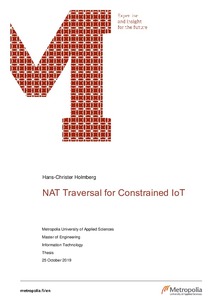NAT Traversal for Constrained IoT
Holmberg, Hans-Christer (2019)
Holmberg, Hans-Christer
2019
All rights reserved. This publication is copyrighted. You may download, display and print it for Your own personal use. Commercial use is prohibited.
Julkaisun pysyvä osoite on
https://urn.fi/URN:NBN:fi:amk-2019102820323
https://urn.fi/URN:NBN:fi:amk-2019102820323
Tiivistelmä
The number of Internet of Things (IoT) devices is rapidly increasing, and it is predicted that the number of deployed IoT devices is going to be counted in tens or hundreds of billions in the years to come. A large amount of these devices is constrained in different ways, e.g., regarding battery power, CPU power, storage, accessibility or connectivity. The connectivity infrastructure might also be constrained, unreliable and limited in bandwidth. Similarly to many other devices connected to the Internet, many of these devices are deployed behind Network Address Translator (NAT) devices, which restrict access to the devices from other devices, e.g., management servers or other IoT devices.
Due to the constraints listed above, it has been realized that traditional NAT traversal mechanisms might not always be feasible for IoT devices and networks, as the mechanisms often require constant connectivity, or support of NAT traversal specific protocols in addition to the protocols used by the devices to perform their functionality. Due to that reason, problems related to NAT traversal have occurred in constrained IoT deployments.
The scope of the thesis was to provide NAT traversal mechanisms for IoT devices using the Constrained Application Protocol (CoAP). However, many of the solutions described in the thesis can be used with, or applied to, other IoT protocols. Part of the study was also to modify a generic NAT traversal mechanism to use only the CoAP protocol and infrastructure. The study was performed by studying the different protocols, and extensions to those protocols, that are used by CoAP, and see whether they can be used for NAT traversal purpose.
The study defines a novel mechanism for collecting and exchanging information required for effective NAT traversal in constrained environments, and how existing IoT standards can be extended in order to realize the mechanism.
Due to the constraints listed above, it has been realized that traditional NAT traversal mechanisms might not always be feasible for IoT devices and networks, as the mechanisms often require constant connectivity, or support of NAT traversal specific protocols in addition to the protocols used by the devices to perform their functionality. Due to that reason, problems related to NAT traversal have occurred in constrained IoT deployments.
The scope of the thesis was to provide NAT traversal mechanisms for IoT devices using the Constrained Application Protocol (CoAP). However, many of the solutions described in the thesis can be used with, or applied to, other IoT protocols. Part of the study was also to modify a generic NAT traversal mechanism to use only the CoAP protocol and infrastructure. The study was performed by studying the different protocols, and extensions to those protocols, that are used by CoAP, and see whether they can be used for NAT traversal purpose.
The study defines a novel mechanism for collecting and exchanging information required for effective NAT traversal in constrained environments, and how existing IoT standards can be extended in order to realize the mechanism.
